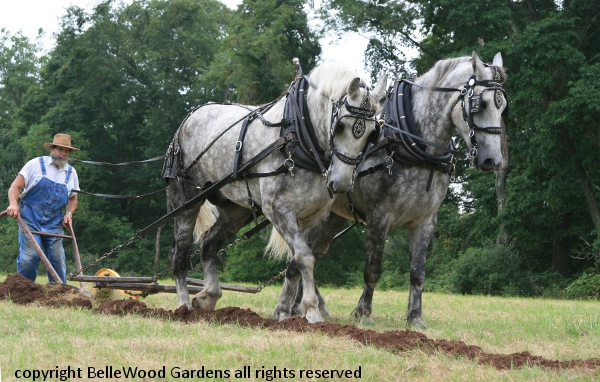
Ted and Bud, a team of dapple gray heavy draft Percheron horses.
The ploughman is Dan Ruth, from Telford, Pennsylannia.
.
If you have any comments, observations, or questions about what you read here, remember you can always Contact Me
All content included on this site such as text, graphics and images is protected by U.S and international copyright law.
The compilation of all content on this site is the exclusive property of the site copyright holder.

Ted and Bud, a team of dapple gray heavy draft Percheron horses.
The ploughman is Dan Ruth, from Telford, Pennsylannia.
Part of the Mercer County parks system, the Howell Living History Farm in Titusville, New Jersey shows farm life in the period between 1890 and 1910. Located within the Pleasant Valley Rural Historic District the 130 acre working farm encompasses 45 tillable acres, 40 acres of woodland, 30 acres of meadows, streams, a pond, and bridge. Listed on the New Jersey State and National Registers of Historic Places, there are five buildings including a 18th century farmhouse and 19th century barn as well as a wagon house, corn crib, ice house. All of the plowing and planting done at Howell Farm is accomplished with horses and equipment representative of the historical time period.
During the year there are special events, from ice harvesting and maple syrup making early in the year to quilting and a corn maze in autumn. Paul and I came today for the plowing match featuring two teams from Howell Farm and nine other teams from New Jersey, Pennsylvania, New York, and even as far away as South Carolina.
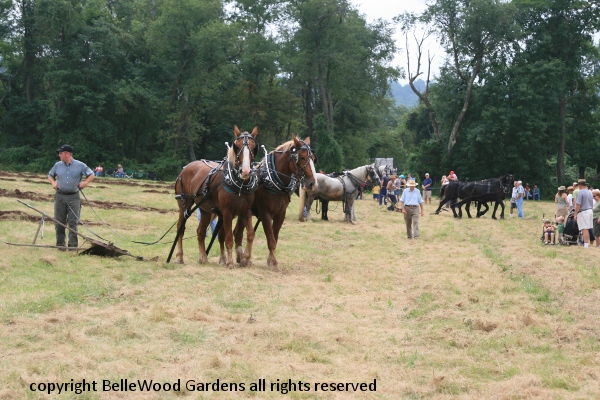
Each team is assigned a "land" to plow. They'll be judged on the straightness of the furrows and how even they are, if the depth and width is uniform, and how well the surface stubble is turned under. The animals should look fit for the work, sound and well muscled, pull evenly and at a steady pace while responding well to the farmer's voice commands and the driving lines.
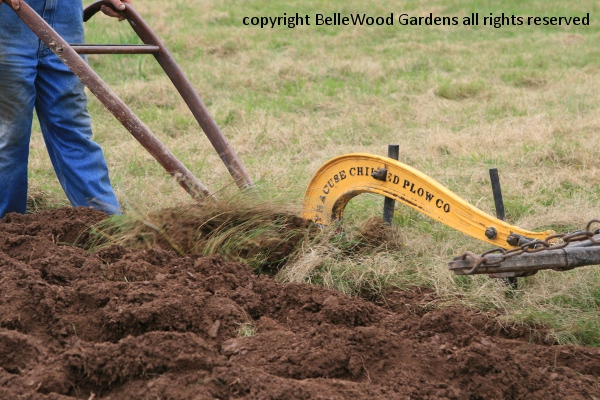
It's not all about the horses - the ploughman handles the plow which should be adjusted so that he need not lift or push down. He needs to keep the end of each furrow even with the previous ones. And it is his responsibility to see that as well as the animals that the harness is clean, well maintained, properly adjusted, and the same for the plow.
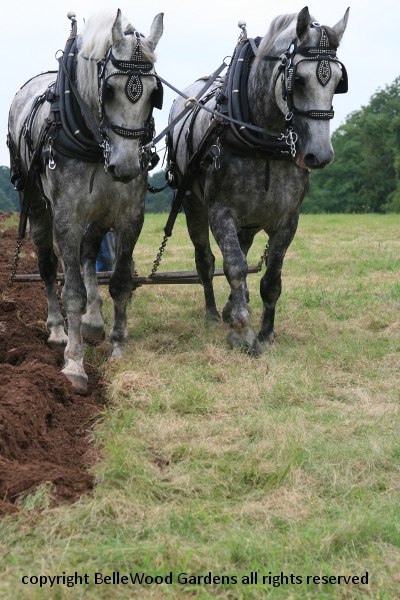
Notice that the near horse is walking down in the furrow. Back in Connecticut, a friend of mine with draft horses said that the horses must always be kept in the same near horse / off horse configuration, even when stalled in the barn and when trailering them to a match.
Draft horses are the heavy breeds developed for farm work, with common traits of strength and a calm temperament. They include the French percheron and eponymous Belgian. Both breeds are here today.
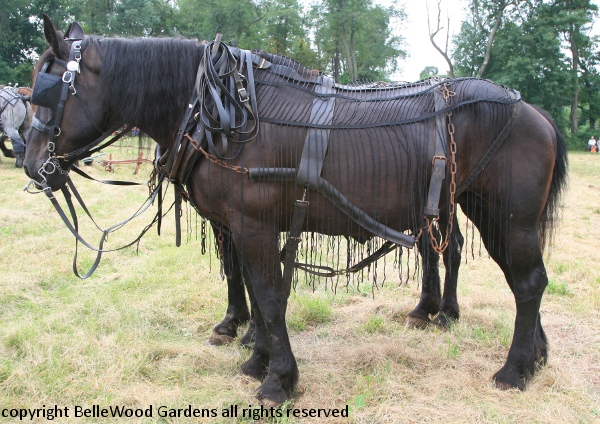
Percheron are commonly seen with two coat colors - gray dapple like Ted and Bud, or black. These two mares are in their 20s and still working. They are wearing fly protection made of thin leather straps. Modern fly sheets would likely keep them too warm. After all, a good team will be plowing about an acre a day.
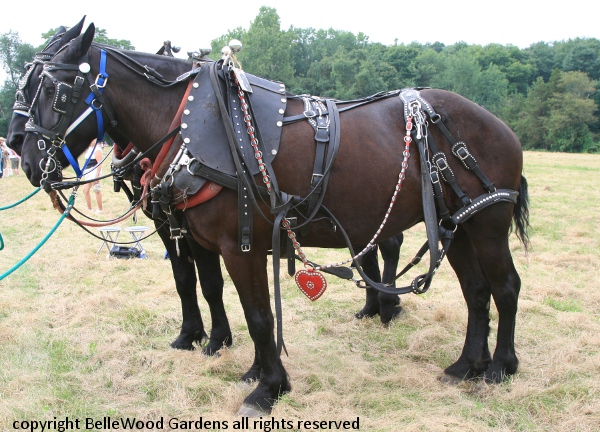
This team's harness has some "bling" to it. My friend back in Connecticut really liked to dress up his teams. Pat and Mike, Rusty and Diamond, their outfits had red tassels and brass ornamentation.

Weighing in at about 2,000 pounds, most American Belgians are light chestnut in color, with a flaxen mane and tail.
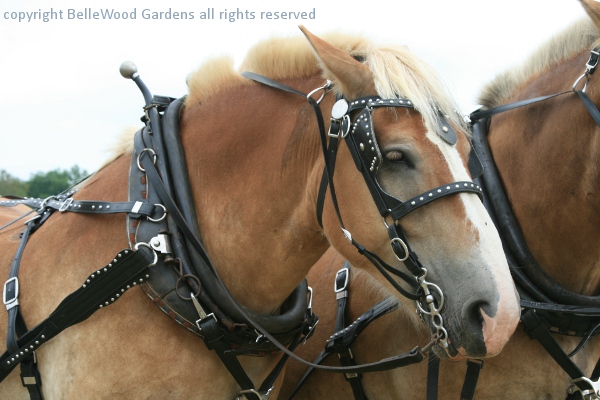
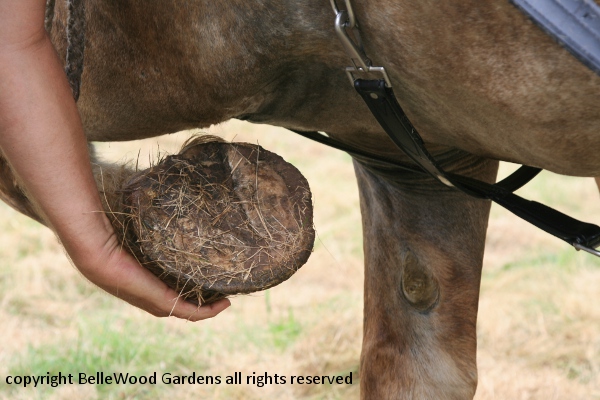
Draft horses have hooves in proportion to their size and weight.

Pat Hlubik has a three-horse hitch. Shawna, the mare in the center of the hitch is more experienced. The two on the outside are Ike and Jeb, young Brabant (European Belgians) stud horses just 3 years old. This is actually their first time working away from the home farm and at first they were uneasy but then settle down and were working well.

And here's a team I referred to as "the odd couple." That's Ada on the left and Gertrude on the right. It seems that Gertrude's former teammate is too old to work. And the younger mule team don't yet have their outfits (working harness, I take that to mean.) So the mule is paired up with Ada since they both have similar personalities.

Her name shortened to Gertie, or even Gert for the voice commands, and the team steps out.
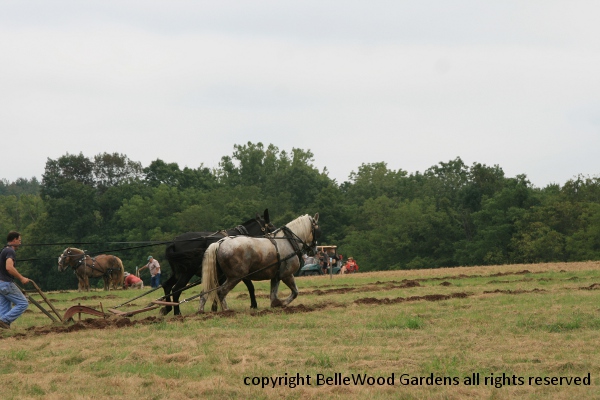
How to plow advice: "Slip the lines over your left shoulder, against your neck and under your right arm. Turn your team to the right every time you reach the end of the field. Put your near horse in the furrow, look up the furrow between the horses, raise both handles slightly, and start your team. The plow slicing through the earth will create the next furrow by laying the strip sod-side down against the preceding one. Walk in the furrow you are making, while your near horse walks in the furrow you are covering. Continue turning to the right until you reach the edge of your plot. You have just completed one land."

Map copyright Howell Farm, Mercer County Parks Commission
After the plowing match is over and visitors have departed the work of the farm continues. The Howell Farm teams will plow the field to join up all the lands plowed by the contestants. Then the field will be harrowed, then dragged, and sown with winter wheat early in October. When it ripens in mid-July the crop will be harvest with a horse drawn reaper binder, after which it will be threshed and ground into flour. The cycle of the seasons follows the turning of the year.
Back to Top
Back to August 2013